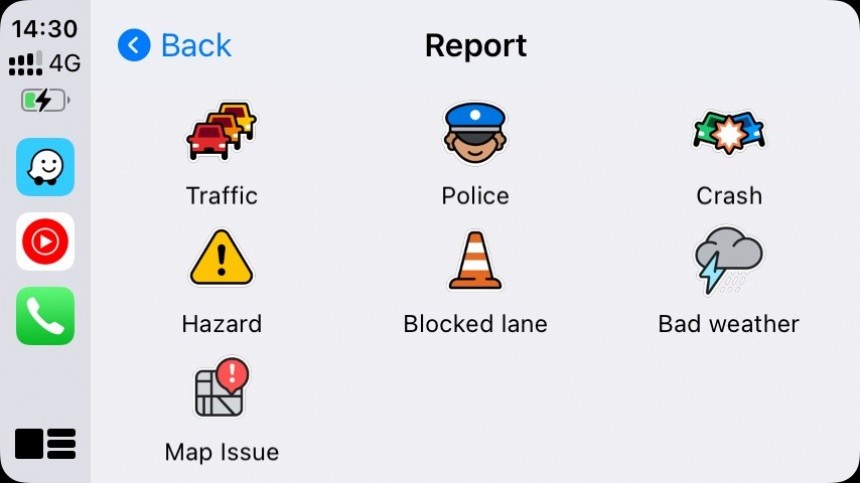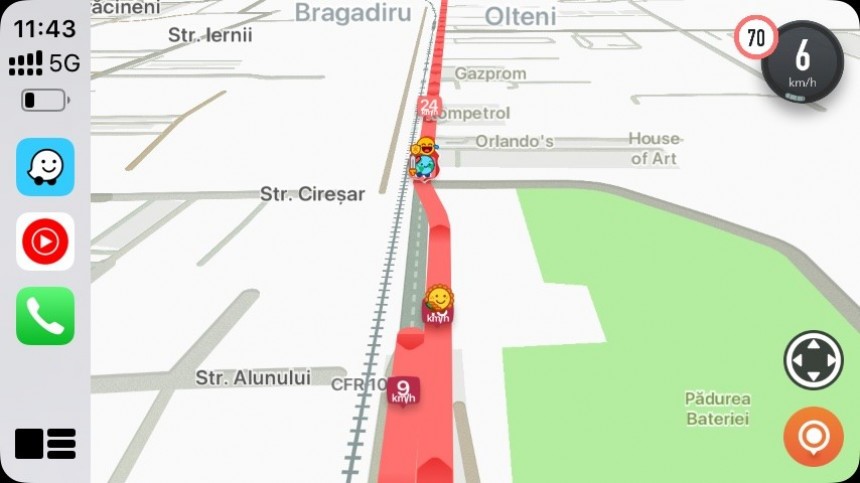Google Maps, Waze, and Apple Maps dominate the navigation space for different reasons. Google Maps and Apple Maps offer a similar feature lineup (especially as Apple is catching up), and their adoption is supported by the apps being pre-loaded with Android and iOS.
Waze is a different beast and offers an approach others have tried but failed to copy.
Compared to Google Maps and Apple Maps, Waze relies entirely on a crowdsourcing engine whose role is to allow users to contribute with traffic data. Google Maps and Apple Maps offer similar capabilities, albeit in a very basic implementation.
Waze encourages users to send traffic reports, and the application uses the uploaded information to generate warnings for other motorists. When you pin a speed trap on the map, Waze generates an alert for other users whose routes go through the same location. They'll get a warning that a police trap is ahead, with the app trying to prevent hard braking, reducing the risk of accidents.
The same approach is used for a wide array of traffic hazards, including accidents, traffic jams, roadkill, vehicles stopped on the side of the road, blocked lanes, and floods. Waze generates alerts, giving users more time to slow down.
The traffic reports don't help the Google-owned company (that's right, Waze is owned by the company that developed Google Maps) find better routes. It still uses aggregate data from devices running the app (similar to Google Maps), and the company even encourages users to keep the app running on their devices, even without navigation. Waze can determine, based on GPS data, where you sit in traffic, so it can determine where traffic jams happen.
Waze is fitted with a wide range of traffic reports and navigation capabilities, but its number one feature is actually you.
Waze wouldn't be able to offer all these features without a solid user base to feed traffic data into its servers. A crowdsourcing engine can't survive without, well, the crowd, and the more users run the app and contribute with traffic information, the more accurate the warnings, the routes, and the ETAs become.
Waze doesn't share how many users run the app every day, but the numbers have undoubtedly increased significantly after the horrible pandemic. Traffic patterns have returned to pre-2020 levels, and we're now battling bumper-to-bumper traffic again. Apps like Waze run in millions of cars, as everybody wants to get to their destinations faster.
All these users contribute with traffic data, helping the parent companies reconfigure their traffic history patterns and calculate new estimates. Google itself admitted that the "new" traffic levels after the health crisis hit the planet broke down Google Maps, making it harder for the app to provide accurate ETAs.
With a gigantic user base, it's easier to address this problem. However, Waze also faced the traffic report challenge, as it needs users to also flag hazards on the map.
If you don't understand how important you are for Waze's successful strategy, look at how Apple tried but already failed to copy the traffic reporting system.
The detailed city experience, now rolling out to users in select regions, provides Apple Maps with a traffic reporting engine similar to the one bundled with Waze (and Google Maps in certain regions). Users can flag the location of accidents, speed traps, and other generic hazards.
However, the limited availability of the feature and its poor adoption, even in regions where it's already live, makes traffic reports on Apple Maps scarce. You can drive with Apple Maps on the screen in a region where the Waze-inspired incident reporting is already available and not see a traffic report for hours.
Apple Maps has a large user base, but people running the app either haven't discovered the traffic reporting engine or received it on their iPhones. Without the users to send traffic reports, this feature won't work, and it's one of the reasons Apple Maps can't replace Waze. Not now, at least, as Apple continues the detailed city experience rollout, so it'll be interesting to see how the Waze user base is affected once the incident reporting system is broadly available.
For people asking the same question for years, Google still has no intention of integrating Waze into Google Maps. The company will keep Google Maps and Waze on the market separately, especially as they have different focuses. Merging the apps could also mean a shrunk user base, as some users might eventually give up on Waze and migrate to a competing product.
However, a merger is still not on the table, and the recent major update received by Waze is living proof that the search giant remains committed to improving the app in the long term. Google Maps now has a different focus, investing more in non-navigation capabilities, including world exploration, business interaction, and reviews. Waze will retain its navigation obsession, sticking with what it does best both now and in the future.
Compared to Google Maps and Apple Maps, Waze relies entirely on a crowdsourcing engine whose role is to allow users to contribute with traffic data. Google Maps and Apple Maps offer similar capabilities, albeit in a very basic implementation.
Waze encourages users to send traffic reports, and the application uses the uploaded information to generate warnings for other motorists. When you pin a speed trap on the map, Waze generates an alert for other users whose routes go through the same location. They'll get a warning that a police trap is ahead, with the app trying to prevent hard braking, reducing the risk of accidents.
The traffic reports don't help the Google-owned company (that's right, Waze is owned by the company that developed Google Maps) find better routes. It still uses aggregate data from devices running the app (similar to Google Maps), and the company even encourages users to keep the app running on their devices, even without navigation. Waze can determine, based on GPS data, where you sit in traffic, so it can determine where traffic jams happen.
Waze is fitted with a wide range of traffic reports and navigation capabilities, but its number one feature is actually you.
Waze doesn't share how many users run the app every day, but the numbers have undoubtedly increased significantly after the horrible pandemic. Traffic patterns have returned to pre-2020 levels, and we're now battling bumper-to-bumper traffic again. Apps like Waze run in millions of cars, as everybody wants to get to their destinations faster.
All these users contribute with traffic data, helping the parent companies reconfigure their traffic history patterns and calculate new estimates. Google itself admitted that the "new" traffic levels after the health crisis hit the planet broke down Google Maps, making it harder for the app to provide accurate ETAs.
If you don't understand how important you are for Waze's successful strategy, look at how Apple tried but already failed to copy the traffic reporting system.
The detailed city experience, now rolling out to users in select regions, provides Apple Maps with a traffic reporting engine similar to the one bundled with Waze (and Google Maps in certain regions). Users can flag the location of accidents, speed traps, and other generic hazards.
However, the limited availability of the feature and its poor adoption, even in regions where it's already live, makes traffic reports on Apple Maps scarce. You can drive with Apple Maps on the screen in a region where the Waze-inspired incident reporting is already available and not see a traffic report for hours.
For people asking the same question for years, Google still has no intention of integrating Waze into Google Maps. The company will keep Google Maps and Waze on the market separately, especially as they have different focuses. Merging the apps could also mean a shrunk user base, as some users might eventually give up on Waze and migrate to a competing product.
However, a merger is still not on the table, and the recent major update received by Waze is living proof that the search giant remains committed to improving the app in the long term. Google Maps now has a different focus, investing more in non-navigation capabilities, including world exploration, business interaction, and reviews. Waze will retain its navigation obsession, sticking with what it does best both now and in the future.










